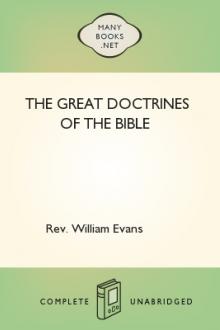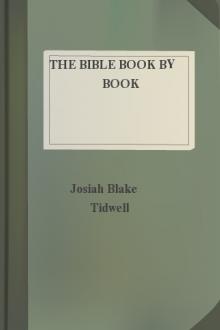The Great Doctrines of the Bible by Rev. William Evans (best books to read for self improvement TXT) 📖

- Author: Rev. William Evans
- Performer: -
Book online «The Great Doctrines of the Bible by Rev. William Evans (best books to read for self improvement TXT) 📖». Author Rev. William Evans
b) Yet the Body of Jesus was more than a mere Natural Body.
It bore marks and possessed attributes which proclaimed a relation to the celestial or supra-terrestrial sphere. For example: It could pass through barred doors (John 20:19), thus transcending physical limitations. It was not recognizable at times (Luke 24: 13-16; John 20:14, 15; 21:4, 12; Mark 16:12). This fact may be accounted for in two ways: First, supernaturally—their eyes were holden; Second, that in that risen life the spiritual controls the material rather than as here, the material the spiritual; so that the spirit could change the outward form of the body at will and at any given time. [Yet, note how Jesus had power to make Himself known by little acts, such as the breaking of the bread, and the tone of His voice. Do we carry these little characteristics into the other life? Shall we know our loved ones by these things?] Then again, Jesus was able to vanish out of sight of His friends (Luke 24:31; John 20:19, 26; Luke 24:51; Acts 1:9). And so He could be in different places at very short intervals of time.
Can we explain these facts? No, not fully. Yet we must not be so material as to totally disbelieve them. “Daily, indeed, are men being forced to recognize that the world holds more mysteries than they formerly imagined it to do. Probably physicists are not so sure of the impenetrability of matter, or even of the conservation of energy, as they once were; and newer speculations on the etheric basis of matter, and on the relation of the seen to the unseen universe (or universes) with forces and laws largely unknown, open up vistas of possibility which may hold in them the key to phenomena even as extraordinary as those in question.”—_James Orr_.
c) Christ’s Resurrection Body was Immortal.
Not only is it true that Christ’s body has not seen death since His resurrection, but it cannot die again. Rom. 6:9, 10; Rev. 1:18, cf. Luke 20:36. [The lesson for us from this: Christ is the firstfruits (1 Cor. 15:20).]
III. THE CREDIBILITY OF THE RESURRECTION OF CHRIST.
Credibility refers to the acceptance of a fact in a manner that deserves belief; it is belief based upon good authority, reliable facts, and competent witnesses. Credulity is belief in a thing without respect to the strength or weakness, reliability or unreliability of the authority, facts, or witnesses; it is a believing too readily, and with no reason for the faith or hope. The resurrection of Christ is a fact proven by competent evidence, and deserving of intelligent acceptance and belief. It is a doctrine buttressed by “many infallible proofs.”
The lines of proof for the credibility of Christ’s resurrection which may be followed in harmony with our purpose are as follows:
1. THE ARGUMENT FROM CAUSE AND EFFECT.
Certain things, conditions, institutions exist in our midst today; they are effects of causes, or a cause; what is that cause? Among these we may mention—
a) The Empty Tomb.
That was an effect; what was its cause? How did that grave become empty? (See under II. a), p. 87). The fact of an empty tomb must be accounted for. How do we account for it? Renan, the French sceptic, wittingly said, and yet how truly: “You Christians live on the fragrance of an empty tomb.”
b) The Lord’s Day.
The Lord’s Day is not the original Sabbath. Who dared change it? For what reason, and on what ground was it changed? Ponder the tenacity with which the Jews held on to their Sabbath given in Eden, and buttressed amid the thunders of Sinai. Recall how Jews would sooner die than fight on the Sabbath day (cf. Titus’ invasion of Jerusalem on the Sabbath). The Jews never celebrated the birthdays of great men; they celebrated events, like the Passover. Yet, in the New Testament times we find Jews changing their time-honored seventh day to the first day of the week, and, contrary to all precedent, calling that day after a man—the Lord’s Day. Here is an effect, a tremendous effect; what was its cause? We cannot have an effect without a cause. The resurrection of our Lord was the cause for this great change in the day of worship.
c) The Christian Church.
We know what a grand and noble institution the Christian church is. What would this world be without it? Its hymns, worship, philanthropy, ministrations of mercy are all known to us. Where did this institution come from? It is an effect, a glorious effect; what is its cause? When the risen Christ appeared unto the discouraged disciples and revived their faith and hope, they went forth, under the all-conquering faith in a risen and ascended Lord, and preached the story of His life, death, resurrection, ascension, and coming again. Men believed these teachings; gathered themselves together to study the Scriptures, to pray, to worship Christ, and to extend His kingdom among men. This is how the church came into existence. Its cause was the resurrection of Christ.
d) The New Testament.
If Jesus Christ had remained buried in the grave, the story of His life and death would have remained buried with Him. The New Testament is an effect of Christ’s resurrection. It was the resurrection that put heart into the disciples to go forth and tell its story. Sceptics would have us believe that the resurrection of Christ was an afterthought of the disciples to give the story of Christ’s life a thrilling climax, a decorative incident which satisfies the dramatic feeling in man, a brilliant picture at the end of an heroic life. We reply: There would have been no beautiful story to put a climax to if there had been no resurrection of the Christ of the story. The resurrection does not grow out of the beautiful story of His life, but the beautiful story of Christ’s life grew out of the fact of the resurrection. The New Testament is the book of the resurrection.
2. THE ARGUMENT FROM TESTIMONY.
a) As to the Number of the Witnesses.
The resurrection of Christ as a historical fact is verified by a sufficient number of witnesses: over five hundred (1 Cor. 15:3-9). In our courts, one witness is enough to establish murder; two, high treason; three, the execution of a will; seven, an oral will. Seven is the greatest number required under our law. Christ’s resurrection had five hundred and fourteen. Is not this a sufficient number?
b) As to the Character of the Witnesses.
The value of the testimony of a witness depends much upon his character; if that is impeached, then the testimony is discounted. Scrutinize carefully the character of the men who bore witness to the fact of Christ’s resurrection. Impeach them if you can. They are unassailable on ethical grounds. “No honorable opponent of the Gospel has ever denied this fact. Their moral greatness awakened an Augustine, a Francis of Assisi, and a Luther. They have been the unrivalled pattern of all mature and moral manhood for nearly two thousand years.” In law much is made of the question of motive. What motive could the apostles have had in perpetrating the story of Christ’s resurrection upon people? Every one of them (except one) died a martyr’s death for his loyalty to the story of Christ’s resurrection. What had they to gain by fraud? Would they have sacrificed their lives for what they themselves believed to be an imposture?
Nor are we to slight the testimony to Christ’s resurrection that comes to us from sources other than that of the inspired writers of the New Testament. Ignatius, a Christian, and a contemporary of Christ, a martyr for his faith in Christ, in his Letter to the Philadelphians, says: “Christ truly suffered, as He also truly raised up Himself. I know that after the resurrection He was in the flesh, and I believe Him to be so still. And when He came to those who were with Peter, He said to them, ‘Take, handle me, and see that I am not an incorporeal phantom!’” Tertullian, in his Apolegeticus, says: “The fame of our Lord’s remarkable resurrection and ascension being now spread abroad, Pontius Pilate, according to an ancient custom of communicating novel occurrences to the emperor, that nothing might escape him, transmitted to Tiberius, Emperor of Rome, an account of the resurrection of our Lord from the dead…Tiberius referred the whole matter to the Senate, who, being unacquainted with the facts, rejected it.” The integrity of this passage is unquestioned by even the most sceptical critics.
Alleged Discrepancies.
[Footnote: The following extract from Dr. Orr’s book, The Resurrection of Jesus, will throw some light on the matter of differences in testimony, while maintaining the credibility of the fact itself. “An instructive example is furnished in a recent issue of the Bibliotheca Sacra. A class in history was studying the French Revolution, and the pupils were asked to look the matter up, and report next day by what vote Louis XVI was condemned. Nearly half the class reported that the vote was unanimous. A considerable number protested that he was condemned by a majority of one. A few gave the majority as 145 in a vote of 721. How utterly irreconcilable these reports seemed! Yet for each the authority of reputable historians could be given. In fact, all were true, and the full truth was a combination of all three. On the first vote as to the king’s guilt there was no contrary voice. Some tell only of this. The vote on the penalty was given individually, with reasons, and a majority of 145 declared for the death penalty, at once or after peace was made with Austria, or after confirmation by the people. The votes for immediate death were only 361 as against 360. History abounds with similar illustrations. As an example of another kind, reference may be made to Rev. R. J. Campbell’s volume of Sermons Addressed to Individuals, where, on pp. 145-6 and pp. 181-2, the same story of a Brighton man is told with affecting dramatic details. The story is no doubt true in substance; but for ‘discrepancies’—let the reader compare them, and never speak more (or Mr. Campbell either) of the Gospels!”]
The seeming differences in the testimony of the witnesses to the resurrection may be largely, if not altogether reconciled by a correct knowledge of the manner and order of the appearances of Christ after His resurrection.
The following order of appearances may help in the understanding of the testimony to the resurrection:
1. The women at the grave see the vision of angels.
2. The women separate at the grave to make known the news —Mary Magdalene going to tell Peter and John, who doubtless lived close by (for it seems that they reached the grave in a single run). The other women go to tell the other disciples who, probably, were at Bethany.
3. Peter and John, hearing the news, run to the grave, leaving Mary. They then return home.
4. Mary follows; lingers at the grave; gets vision of the Master, and command to go tell the disciples.
5. The other women see Christ on the way.
6. Christ appears to the two on the way to Emmaus.
7. To Simon Peter.
8. To the ten apostles, and other friends.
9. To the apostles at Tiberias.
10. To the apostles and multitude on the mount.
11. To the disciples and friends at the ascension.
12. To James (1 Cor. 15:7).
13. To Paul (1 Cor. 15:8).
IV. THE





Comments (0)